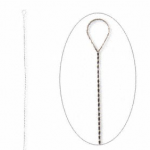Here is a copy of a note I sent out to my students. I thought it might be of general interest.
I wanted to update you on a couple of developments occurring in the trade affecting pearl and bead stringers that may be useful to know.
 Changes in Bead Stringing Needle Designations
Changes in Bead Stringing Needle Designations
A note from a student highlighted a change occurring in the jewelry supply industry with regard to needles. The student said she was unable to purchase #7 needles, a size I recommended in the DVDs. Instead, she said her jewelry supplier was selling light, medium and heavy needles.
As you know, pearl and bead stringers use flexible, twisted wire needles to string jewelry. These needles have large eyes that collapse when the needle is drawn through the beads. And because the needle itself is flexible, it can be used efficiently when attaching beads to complex clasps. A further advantage is that should the needle be bent during manufacture, especially at a right angle, the bent or unusable portion can be clipped off, enabling the stringer to continue without adding a second needle. (The only way a needle can be added is by adding thread, a technique I teach in the Advanced Pearl and Bead Stringing DVD.)
In the DVDs, I suggested that students use #7 needles. I’ve used them for years. They’re all purpose. They can be used with the smallest and largest beads. However, for years, I’ve just picked up needles by eyeballing them without noticing the number or size.
In the past, needles were given numbers with the lightest at the lower end of the scale. So, I was interested when this alert student notified me that she was having trouble identifying the appropriate number.
I checked with a couple of major suppliers and it does appear that a change is underway or at least partially underway. Fire Mountain Gems is selling needles it designates as “light-medium,” “medium-heavy” and “light.” When I spoke with a customer service representative, she said that they’re not selling needles with numbers any more. BUT, this isn’t quite true. I noticed that they’re also selling a light twisted #6 needle. Here is the link. https://www.firemountaingems.com/details.asp?PN=H201043BS
I also talked with Jemco, www.jemcousa.com, a very fine jewelry supply company. They, too, said they’re selling needles but only in three categories, light, medium and heavy.
My advice is not to overly complicate this which I hope I’m not doing now. The major thing to look for in buying a needle is that the eye is big enough to accommodate the thread you’re using. Since most of us don’t use heavy, heavy thread, a medium or light needle should be a good all purpose solution. In addition, remember that all too frequently drill holes are irregular. A thinner needle has a greater chance of slipping through irregularly drilled beads than a thicker one.
Fire Mountain Gems, a very good company, suggests buying needles based on the size of the beads. However, frankly, this is irrelevant to me. The bead size isn’t important (unless of course the beads are so large you need a longer needle). What’s important is that the eye accommodates the thread and that when it collapses the needle and the thread can be pulled through the drill hole.
Dealers Shorting Bead Strand Lengths
When we buy strands of beads, we are buying from what’s called a “hank.” Hanks are ten strands of beads tied together. (Often you’ll get a discount if you buy the entire hank.) Traditionally, a strand of beads is 16” long, enough to create a 17″ choker length necklace. (Generally, 16” of beads plus an inch for knots and clasp.)
Recently, I’ve noticed that a number of dealers are shorting the strands, that is, they’re selling strands that are short by a couple of inches.
Dealers have always done this for very expensive gemstones such as diamond beads where the manufacturer may not need an entire 16”. However, now I’m seeing more and more dealers do this for less expensive gemstones, onyx, hematite, etc.
This is regrettable. There is nothing more frustrating than to assume you’ve bought a 16” strand only to discover it’s really a 14” or 15” strand. So use care when you’re buying. One tip might be to bring along a strand you know is 16” and measure the strand you’re contemplating against it. Or just eyeball it. You can usually tell if it’s short.
Increases in Theft
I wanted to take the opportunity here to caution you about the increase in thefts we’re seeing across all industry segments. I’m hearing from dealers of loose beads and manufactured jewelry that this is a serious and escalating problem.
Here is some advice: Do not mail anything that has “jewelry” on the label. It’s an invitation. Be especially careful if you’re showing your jewelry at a home or craft show. Better yet, invest in some kind of jewelry display case. (The best opportunity for thieves is when you’re distracted with another customer.) If you can’t afford a jewelry display case, bring a friend along or share a booth. In any event, do not leave your table or booth unattended. If someone wants to buy a piece of jewelry from you, do not let it go out without first processing the check or checking to ensure the money has been deposited.
I hope that the increase we’re seeing is temporary and a result of tough economic times. But whatever the reason, take commonsense precautions.
For questions and comments, please email fleury@fsommers.com
Best regards,
Fleury

